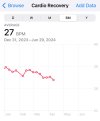I like you Doctor.So, I’m an ER doc (like this Sean O’Mara guy, apparently), and as such I look at CT scans of the abdomen and pelvis every shift (the radiologist provides the official read, but I always personally review the images as well). Do you want to know who has a lot of visceral fat? Fat people. Do you know who doesn’t have a lot of visceral fat? Lean people.
I have never seen an endurance athlete with excess visceral fat.
You are using an out of date browser. It may not display this or other websites correctly.
You should upgrade or use an alternative browser.
You should upgrade or use an alternative browser.
Other/Mixed New to HIIT; Need advice on hiking and visceral fat.
- Thread starter mdavis121212
- Start date
Other strength modalities (e.g., Clubs), mixed strength modalities (e.g., combined kettlebell and barbell), other goals (flexibility)
silveraw
Level 9 Valued Member
It might do something, but when I compare it to the results I get from things like hill sprints, it seems like the work reward ratio is off.But a hard 10*3 on the minute? I have hard time thinking it doesn't do a thing.
I’ve always found that when I do Z2 and sprints my intraset recovery skyrockets. Making OTM sets easier than just doing OTM sets. But might be where my personal cardio deficits lay.
I know Harold Moz was/is a huge fan of OTM sets (with interval training too though).
Also I’m assuming you would so more than three minutes OTM, 10/3 OTM I don’t think would do much of anything at all.
What if it’s 10 sets of 3 OTM?It might do something, but when I compare it to the results I get from things like hill sprints, it seems like the work reward ratio is off.
I’ve always found that when I do Z2 and sprints my intraset recovery skyrockets. Making OTM sets easier than just doing OTM sets. But might be where my personal cardio deficits lay.
I know Harold Moz was/is a huge fan of OTM sets (with interval training too though).
Also I’m assuming you would so more than three minutes OTM, 10/3 OTM I don’t think would do much of anything at all.
Antti
Level 10 Valued Member
It might do something, but when I compare it to the results I get from things like hill sprints, it seems like the work reward ratio is off.
I’ve always found that when I do Z2 and sprints my intraset recovery skyrockets. Making OTM sets easier than just doing OTM sets. But might be where my personal cardio deficits lay.
I know Harold Moz was/is a huge fan of OTM sets (with interval training too though).
Also I’m assuming you would so more than three minutes OTM, 10/3 OTM I don’t think would do much of anything at all.
What exactly are you comparing when it comes to training? And what were the results?
@John K is correct, I meant ten triples, each triple starting on the minute. Like the classic Westside protocol, ten triples of 50-60% of 1RM + 25% of 1RM band resistance on top.
When it comes to work reward ratio I'm not sure there's anything better.
silveraw
Level 9 Valued Member
Intra set recovery and what I guess is “general work capacity”. Eg, how gassed I am after medley work. Those are the big subjective attributes. For hard numbers i look at trending changes in resting HR and HRR. (I’m not measuring set recovery times)What exactly are you comparing when it comes to training? And what were the results?
Eg here are my recent base building block and high intensity blocks from this year. February had I had a bit of a sickness but got back in trend
Attachments
silveraw
Level 9 Valued Member
Perhaps because I’m already doing a lot of AMRAP and medley work I don’t see as big a result.Like the classic Westside protocol, ten triples of 50-60% of 1RM + 25% of 1RM band resistance on top.
When it comes to work reward ratio I'm not sure there's anything better.
It would be interesting to see what changes you have if you did 3-6 weeks of assault bike intervals/hill sprints compared to your OTM work. Or even the easy “base building” of 30 min zone two steady state 3x a week for 3-6 weeks.
Also I’m unsure of when last I did OTM squats. So maybe I’m lumping my rippetoe cardio expertise with that.
silveraw
Level 9 Valued Member
It should be apparent at this point I don’t read goodWhat if it’s 10 sets of 3 OTM?
Antti
Level 10 Valued Member
Perhaps because I’m already doing a lot of AMRAP and medley work I don’t see as big a result.
It would be interesting to see what changes you have if you did 3-6 weeks of assault bike intervals/hill sprints compared to your OTM work. Or even the easy “base building” of 30 min zone two steady state 3x a week for 3-6 weeks.
Also I’m unsure of when last I did OTM squats. So maybe I’m lumping my rippetoe cardio expertise with that.
Ir would be interesting to see the changes for me but I'm not sure what the metrics should be.
For example, there are or have been weeks where I easily get the three or more sessions of 30-60 min Z2, but I don't really notice a difference anywhere. Maybe I'm not consistent enough with it, but then again, I would expect the biggest difference right jn the beginning.
I'm not at all keen on doing any less strength training so it would have to be on top of it. That's another challenge.
Throw in 1 day a week of the Norwegian 4 x 4. Four minutes balls to the wall followed by 3 minutes of rest, x 4.Ir would be interesting to see the changes for me but I'm not sure what the metrics should be.
For example, there are or have been weeks where I easily get the three or more sessions of 30-60 min Z2, but I don't really notice a difference anywhere. Maybe I'm not consistent enough with it, but then again, I would expect the biggest difference right jn the beginning.
I'm not at all keen on doing any less strength training so it would have to be on top of it. That's another challenge.
silveraw
Level 9 Valued Member
I tend to notice it at week 3-5. The constraint switches from lungs to legs and it gets hard.would expect the biggest difference right jn the beginning
puddleduck
Level 5 Valued Member
Didn’t realise you were meaning west side style DE work… honestly I don’t think that’s going to provide any cardiovascular benefits at all, beyond the kind you get from basic fidgeting and standing up.
North Coast Miller
Level 9 Valued Member
Didn’t realise you were meaning west side style DE work… honestly I don’t think that’s going to provide any cardiovascular benefits at all, beyond the kind you get from basic fidgeting and standing up.
I agree.
Antti
Level 10 Valued Member
Didn’t realise you were meaning west side style DE work… honestly I don’t think that’s going to provide any cardiovascular benefits at all, beyond the kind you get from basic fidgeting and standing up.
I agree.
When I see/have people do speed work, their lungs are typically the limiting factor. The legs could squat, but they're too out of breath to keep up the effort. I may be simple but I would expect the training to develop that which it challenges.
puddleduck
Level 5 Valued Member
It’s a total anaerobic effort though. I’m surprised lungs would be a limiting factor. I’d have assumed speed strength is the very opposite end of the continuum
Antti
Level 10 Valued Member
It’s a total anaerobic effort though. I’m surprised lungs would be a limiting factor. I’d have assumed speed strength is the very opposite end of the continuum
Calling it speed works at all times isn't likely true. Maybe a better term would be compensatory acceleration training.
Personally, I recommend a wide variety of loads. The effort must be as high as possible. And with proficiency the loads still become very heavy and the total volume will be a heavy workload, especially in the time frame.
North Coast Miller
Level 9 Valued Member
When I see/have people do speed work, their lungs are typically the limiting factor. The legs could squat, but they're too out of breath to keep up the effort. I may be simple but I would expect the training to develop that which it challenges.
I'm no expert, but personally found that improving loaded movement to exhaustion was not really influenced by training it sub max. Word salad - the response was all anaerobic. It had no effect on resting HR. It DID improve my mental state on follow-up efforts.
Doing high rep BB type training did push up my submax volume to exhaustion but that was probably by improving local glucose stores and not via cardio improvements.
It wasn't until I started running my intervals as close to Tabata as my conditioning would allow that I saw an improvement in that sort of metric independent of increasing 1RM. Resting hr went down and between set recovery notably improved.
Another possible avenue might be oscillating reps, but that is likewise liable to increase 1RM in the process.
Not saying it isn't possible, or that your volume won't improve. I would be pretty surprised if it improved your 5k run time, resting heart rate etc.
silveraw
Level 9 Valued Member
Do you get any measurable improvements? Does the constraint change/lessen as you challenge it?When I see/have people do speed work, their lungs are typically the limiting factor. The legs could squat, but they're too out of breath to keep up the effort. I may be simple but I would expect the training to develop that which it challenges.
And the ultimate litmus test for powerlifting cardio, what HR zone is tying your shoes?
Nah man, that loud a$$ breathing/whistling is a deviated septum ( ha ) not their gut smashing up against their heart and lungs.Do you get any measurable improvements? Does the constraint change/lessen as you challenge it?
And the ultimate litmus test for powerlifting cardio, what HR zone is tying your shoes?
Antti
Level 10 Valued Member
Do you get any measurable improvements? Does the constraint change/lessen as you challenge it?
And the ultimate litmus test for powerlifting cardio, what HR zone is tying your shoes?
It does get a lot easier with time and experience. I've not compared my heart rates. I think I will.
When it comes to shoes, I give you two words: boots and velcro.


